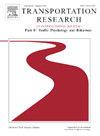如何才能让城乡通勤者从驾车出行转变为拼车出行?
IF 4.4
2区 工程技术
Q1 PSYCHOLOGY, APPLIED
Transportation Research Part F-Traffic Psychology and Behaviour
Pub Date : 2024-10-19
DOI:10.1016/j.trf.2024.10.007
引用次数: 0
摘要
本研究旨在确定提高拼车意愿的潜在方法,尤其是在城乡出行环境中,因为在这种环境中(由于人口密度低)没有或只有极少量的公共交通服务,而且购买私人车辆对许多家庭来说构成了巨大的经济负担。为此,我们使用了时间灵活性作为拼车意愿的替代指标,时间灵活性的定义是对通勤时间增加的容忍度(拼车时可能会因为重新安排路线和接载他人而增加通勤时间)。我们利用结构方程模型和对居住在宾夕法尼亚州中部一个农村县城的约 1000 名工人和大学生的调查反馈,分析了在拼车时可能导致更高的时间灵活性的社会人口、态度和情景因素。我们还调查了当人们获得金钱奖励(报销旅行费用)时,他们的时间灵活性是否会发生变化。结果表明,开车爱好者和在旅行时寻求隐私的人会降低时间灵活性,而注重环境和健康的人会提高时间灵活性。此外,女性、过去曾有过不便的拼车经历的人以及居住地离工作地点/学校较近(开车 20 分钟以内)的人的时间灵活性较低。另一方面,收入较低、驾车成本较高的人如果能报销部分交通费用,则愿意忍受较长的通勤时间。我们还发现,如果最初没有拼车的意愿,那么报销优惠也不会对人们的决定产生太大的影响。本文章由计算机程序翻译,如有差异,请以英文原文为准。
What does it take for rural-urban commuters to switch from driving to carpooling?
This study aims at identifying the potential ways to increase the willingness to carpool, particularly in rural–urban travel settings, where there is no/minimal public transit service (due to low population density) and purchasing a personal vehicle poses a significant financial burden for many households. To do so, we used time flexibility, defined as the tolerance for increased commute time (which can happen because of re-routing and picking up others when carpooling), as a proxy to willingness to carpool. Using structural equation modeling and survey responses from about 1000 workers and college students living in a rural county in Central Pennsylvania, we analyzed the sociodemographic, attitudinal, and situational factors that can lead to higher time flexibility when carpooling. We also investigated whether people’s time flexibility changes when they are offered monetary incentives (in terms of travel costs reimbursement). The results indicated that being a driving fan and seeking privacy when traveling reduces time flexibility, while being conscientious about environment and health leads to higher time flexibility. Moreover, females, people who had inconvenient past carpool experiences, and those living closer (within 20 min of driving) to their workplace/college showed lower time flexibility. On the other hand, people with lower income and higher driving costs were willing to tolerate longer commute times if reimbursed for a portion of their travel costs. We also found that if there is no initial level of willingness to carpool, reimbursement offers cannot do much to sway people’s decisions.
求助全文
通过发布文献求助,成功后即可免费获取论文全文。
去求助
来源期刊
CiteScore
7.60
自引率
14.60%
发文量
239
审稿时长
71 days
期刊介绍:
Transportation Research Part F: Traffic Psychology and Behaviour focuses on the behavioural and psychological aspects of traffic and transport. The aim of the journal is to enhance theory development, improve the quality of empirical studies and to stimulate the application of research findings in practice. TRF provides a focus and a means of communication for the considerable amount of research activities that are now being carried out in this field. The journal provides a forum for transportation researchers, psychologists, ergonomists, engineers and policy-makers with an interest in traffic and transport psychology.

 求助内容:
求助内容: 应助结果提醒方式:
应助结果提醒方式:


